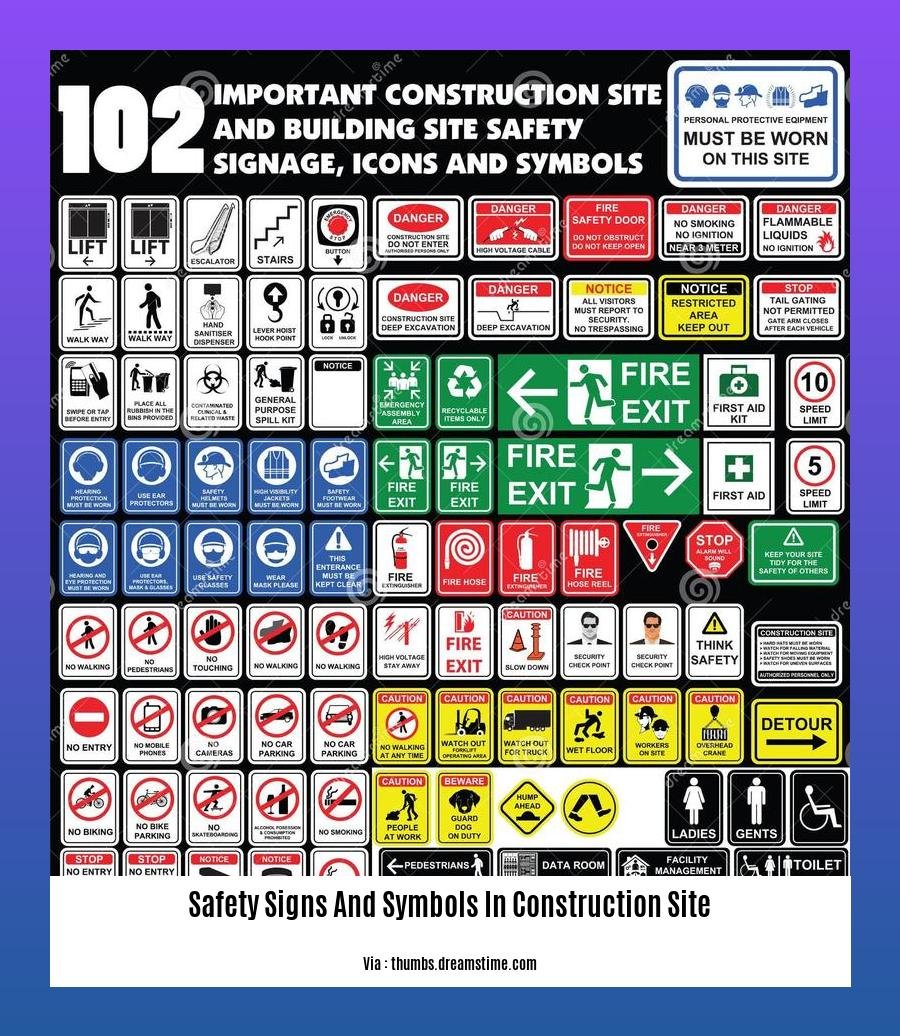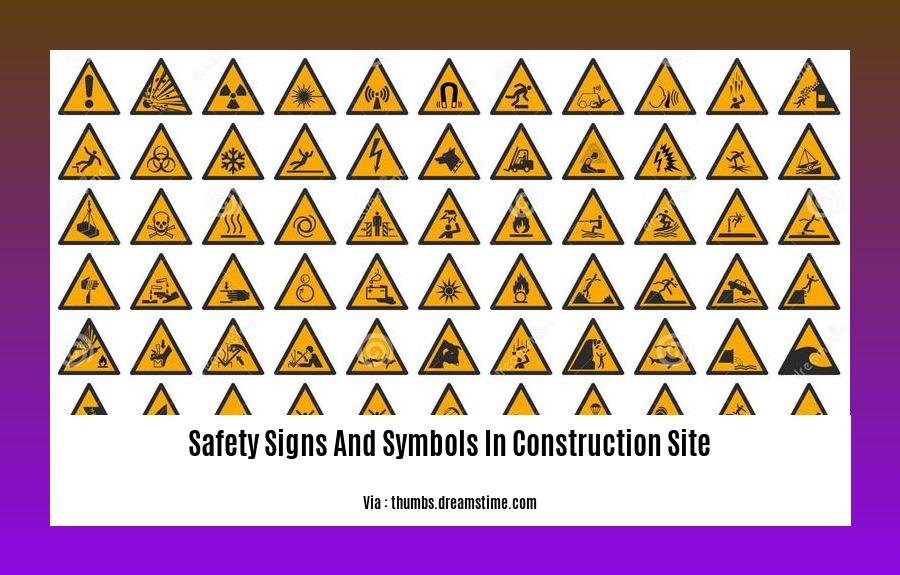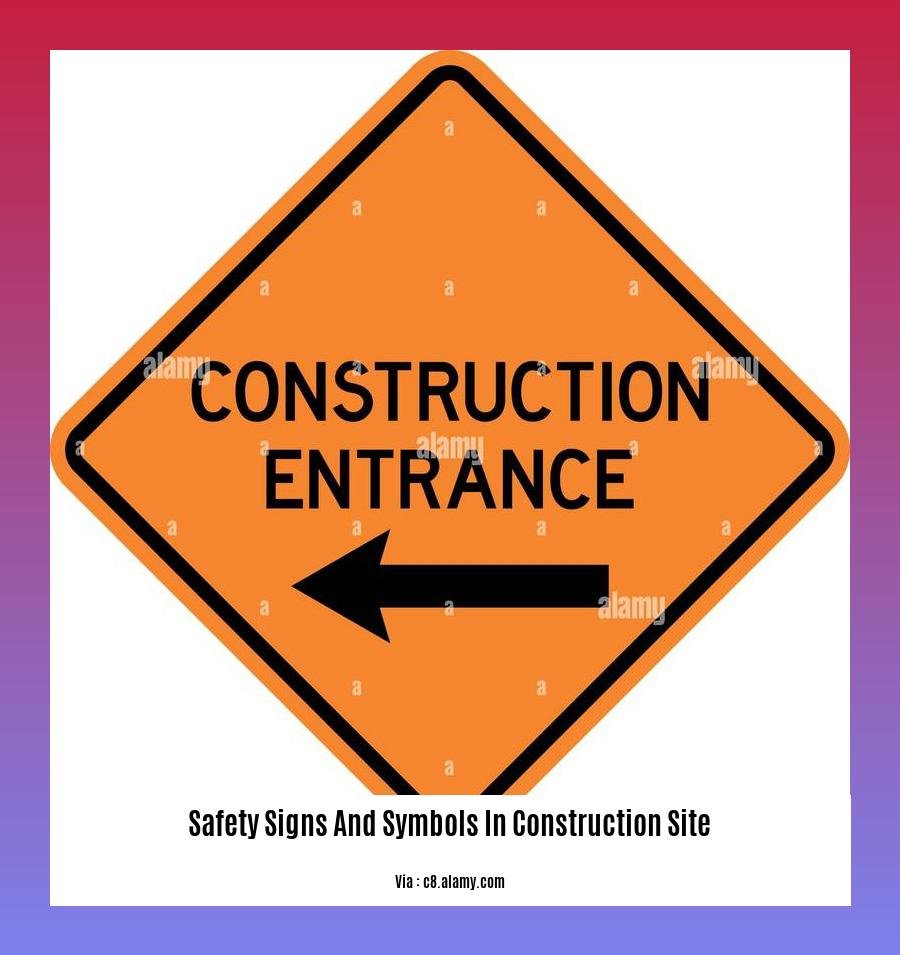[A Comprehensive Guide to Safety Signs and Symbols in Construction Sites]. These visual cues play a fundamental role in keeping workers safe and informed in hazardous construction environments. By clearly communicating potential hazards and emergency procedures, they help prevent accidents, injuries, and fatalities. In this comprehensive guide, we will delve into the types, importance, and proper placement of safety signs and symbols in construction sites, providing valuable insights for safety managers, contractors, and all stakeholders involved in creating a safe workplace.
Key Takeaways:
- Construction safety signs and symbols are essential for communicating safety information.
- They fall into five categories: prohibition, mandatory, warning, safe condition, and fire equipment.
- They enhance safety by providing clear instructions and hazard alerts.
- Adherence to signs and symbols complies with regulations, reduces accidents, and fosters communication.
- They are vital for emergency response and safety equipment identification.
Safety Signs and Symbols in Construction Sites

Visual cues like safety signs and symbols in construction sites are vital for safety communication, ensuring workers understand potential hazards, precautions, and emergency procedures. These signs and symbols are categorized into distinct types:
- Prohibition Signs (Red): Prohibit actions like smoking, entry, or parking.
- Mandatory Signs (Blue): Enforce safety measures, such as wearing protective gear or adhering to procedures.
- Warning Signs (Yellow): Alert to potential hazards, like construction work or electrical risks.
- Safe Condition Signs (Green): Indicate safe areas, such as emergency exits, first aid kits, or fire extinguishers.
- Fire Equipment Signs (Red): Guide workers to fire safety equipment, like alarms and hoses.
These signs are essential for several reasons:
- Enhanced Safety: They provide clear instructions and warnings, promoting hazard awareness and reducing accidents.
- OSHA Compliance: They meet the requirements of the Occupational Safety and Health Administration (OSHA).
- Improved Communication: They facilitate effective communication and coordination among workers.
- Efficient Emergency Response: They guide workers to safety equipment, ensuring prompt response during emergencies.
To ensure the effectiveness of safety signs and symbols in construction sites, they must be:
- Visible: Placed in conspicuous locations with unobstructed visibility.
- Legible: Use clear, concise text and symbols that are easily understandable.
- Appropriate: Choose signs and symbols that are relevant to the specific hazards and precautions on the site.
- Maintained: Regularly inspect and replace signs that are damaged or faded to maintain their effectiveness.
By adhering to these guidelines and incorporating safety signs and symbols in construction sites, companies can create a safer work environment, enhance compliance, and promote the well-being of their workers.
-
Explore comprehensive guidelines for maintaining a secure work environment in the construction industry by clicking on safety rules in construction.
-
Enhance your understanding of visual cues that safeguard construction sites by following this link to safety signs in construction.
-
Gain insights into effective signage strategies for construction sites by clicking on safety signs in a construction site.
-
Inspire a culture of safety on construction sites by incorporating safety slogans for construction into your communication.
Placement and Visibility of Safety Signs and Symbols

Safety signs are fundamental for communicating vital information on construction sites. Their proper placement and visibility ensure they effectively alert workers to potential hazards and promote safety.
H3: Guidelines for Effective Placement
When placing safety signs, consider these guidelines to maximize their impact:
- High Visibility: Position signs in highly visible areas where workers can easily spot them. Eye level is ideal, avoiding obstructions from equipment or materials.
- Appropriate Distance: Determine the distance between signs based on potential hazards. Signs should be visible from a safe distance to provide timely warnings.
- Avoid Overcrowding: Avoid cluttering areas with too many signs. Overcrowding can hinder visibility and create confusion.
H3: Ensuring Sign Visibility
Ensuring sign visibility is crucial for clear communication:
- Contrasting Colors and Background: Use bright colors and contrasting backgrounds to make signs stand out.
- Large and Readable: Design signs large enough to be easily read from a distance. Use clear, legible fonts and remove any unnecessary text.
- Regular Maintenance: Regularly inspect and replace signs to maintain their visibility. Faded, damaged, or obscured signs can compromise safety.
Key Takeaways:
- Proper placement ensures signs are visible and accessible.
- High visibility enhances the effectiveness of safety signs.
- Regular maintenance prolongs their lifespan and ensures clear communication.
Relevant URL Sources:
Responsibilities of Workers Regarding Safety Signs and Symbols
Hey there, hard-hat heroes!
On a construction site, safety is paramount. And one crucial element of staying safe is understanding the language of safety signs and symbols. They’re like the traffic lights of our work zone, guiding us clear of potential hazards. But just like traffic lights, it’s not enough to simply glance at them. We need to take responsibility for understanding and following their instructions.
Responsibilities of Workers
When it comes to safety signs and symbols, it’s not just a passive “look and acknowledge” situation. Workers have a proactive role to play:
-
Recognize and Understand: Get familiar with the different types of safety signs (prohibition, warning, mandatory, etc.) and learn what they mean. Remember, red means “Stop,” yellow means “Caution,” and green means “Go.”
-
Obey Instructions: Safety signs are not just suggestions. They’re there to protect you. So, follow their instructions diligently. If a sign says “Wear a hard hat,” put one on.
-
Remain Alert: Keep an eye out for safety signs and symbols at all times. Don’t let distractions get in the way of your vigilance.
-
Report Issues: If you notice any damaged or missing safety signs, report it to your supervisor immediately. Safety signs are like your guardians, and they need to be in tip-top shape to do their job.
-
Stay Informed: Attend safety meetings and trainings to stay up-to-date on the latest safety protocols and the meaning of specific signs and symbols used on your site. Knowledge is power, especially when it comes to staying safe.
Remember, neglecting safety signs and symbols is not only a personal risk but also puts your team at potential danger. Embrace your responsibility, learn the safety lingo, and work together to create a safe and healthy work environment. It might not be as exciting as scaling a skyscraper, but it’s the ultimate foundation for a successful job.
Key Takeaways:
- Workers are responsible for recognizing, understanding, and obeying safety signs and symbols.
- Safety signs are not just suggestions but crucial instructions that must be followed.
- Remaining alert and reporting any issues with safety signs is essential.
- Attending safety meetings and trainings helps workers stay informed about safety protocols.
- Neglecting safety signs and symbols puts workers and their team at risk.
Relevant URL Sources:
- HSE Blog: Safety Signs, Symbol, and Their Meanings
- Anbu Safety: Safety Signs, Symbols and Their Meanings in the Workplace
Consequences of ignoring or misinterpreting safety signs and symbols
In construction sites, safety signs and symbols are crucial for ensuring a hazard-free work environment. However, ignoring or misinterpreting them can have severe consequences, including:
-
Increased risk of accidents: Safety signs and symbols provide clear instructions on potential hazards and safe behaviors. Ignoring them increases the probability of accidents, injuries, or even fatalities.
-
Non-compliance with regulations: OSHA and other regulatory bodies require the proper use of safety signs and symbols. Ignoring or misinterpreting them can lead to penalties or fines for non-compliance.
-
Reduced worker morale: When workers see that safety signs and symbols are not taken seriously, it can erode their trust in the company’s commitment to their well-being. This can lead to lower morale and decreased productivity.
-
Damage to property and equipment: Ignoring safety signs and symbols can result in accidents that damage equipment or infrastructure, leading to costly repairs or replacements.
-
Loss of confidence: Failure to adhere to safety protocols can damage a company’s reputation and loss of confidence from clients and stakeholders, negatively impacting its credibility.
Key Takeaways:
-
Safety signs and symbols are vital for preventing accidents and promoting a safe work environment.
-
Ignoring or misinterpreting these signs can have serious consequences, including injuries, fines, and damage to property.
-
It is essential to ensure that workers understand and follow safety protocols for their well-being and productivity.
Relevant URL Sources:
-
Importance of Safety Signs and Symbols in the Workplace
-
Consequences of Ignoring Safety Signs and Symbols
FAQ
Q1: What are the benefits of using safety signs and symbols in construction sites?
A1: Safety signs and symbols are crucial in construction sites as they provide clear instructions and warnings, promote hazard awareness, and enhance safety by ensuring compliance with regulations and improving communication among workers.
Q2: What are the different types of safety signs and symbols used in construction?
A2: Construction safety signs and symbols include prohibition signs (red), mandatory signs (blue), warning signs (yellow), safe condition signs (green), and fire equipment signs (red). Each type conveys specific information regarding hazards, precautions, and emergency procedures.
Q3: Where should safety signs and symbols be placed in construction sites?
A3: Safety signs and symbols should be placed in highly visible locations, unobstructed by objects or equipment, and at eye level. Considerations include the distance from potential hazards and avoiding overcrowding the area with signs.
Q4: What are the color codes used for safety signs and symbols?
A4: Safety signs and symbols use color coding to convey their meaning: red for prohibition or danger, yellow or orange for warning or caution, and blue or green for mandatory or safe condition.
Q5: What are GHS pictograms and how are they used in construction sites?
A5: GHS pictograms are graphic labels that communicate potential risks associated with specific chemicals and materials. In construction sites, they are used to classify hazards and assist in compliance with health and safety regulations.
- How to Get Rid of Ants in the Washroom: A Complete Guide - March 31, 2025
- How Much Does Ant Extermination Cost? (2024 Guide & DIY Options) - March 31, 2025
- Best Ant Bait for Carpenter Ants: A Complete Guide - March 31, 2025










